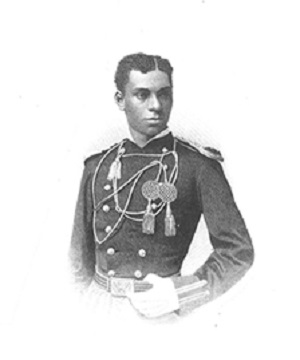
Courtesy of the United States Military Academy at West Point
In 1866, to increase the size of the United States Army, Congress enacted legislation that changed the course of American military history. Opposed by many, the historic law created new regiments, two cavalry and four infantry units, which Congress stipulated “shall be composed of colored men.” For the first time, African Americans could serve in times of peace and received the guarantee of a permanent place in the United States Armed Forces. The new black regiments that later became known as the Buffalo Soldiers would serve at many U.S. Army posts, including Fort Davis, where they became key players in the defense of West Texas during the Indian Wars. They proved instrumental in the defeat of Apache Chief Victorio and in the settlement of America’s western frontier. Fort Davis National Historic Site commemorates the service of these brave African-American soldiers to the nation and tells the story of their impact on military history.
Established in 1854, Fort Davis was important in guarding and establishing America’s western frontier. Troops stationed at this historic military post served to protect emigrants, families, freighters, and mail coaches from the American Indians and bandits who raided travelers on the San Antonio-El Paso Road. In the first seven years, the post’s initial occupants, six companies of the Eighth Infantry under Lt. Col. Washington Seawell, often spent their days pursuing Comanche, Kiowa, and Apache to ensure the safety of those traveling west.
Troops continued to perform this duty until the outbreak of the Civil War. Texas seceded from the Union and federal forces evacuated the fort in April 1861. Confederate troops occupied Fort Davis until August 1862. Then the post remained deserted until 1867, at which time the Ninth Cavalry, one of the new African-American regiments, arrived.
At Fort Davis, in the years following the Civil War, the all-black Ninth Cavalry under the leadership of Lt. Col. Wesley Merritt stayed busy patrolling for the elusive Apache and Comanche and protecting travelers, freight wagons, and mail coaches on the San Antonio-El Paso Road. Meanwhile, a large group of mostly civilian laborers built a new fort not far from the original site. The African-American troops also helped develop new roads and improve communication with other posts by stringing 91 miles of telegraph wire. At some point during the Indian Wars, African-American soldiers acquired the nickname "Buffalo Soldiers," which is believed to have come originally from the Plains Indians. Recent scholarship reveals that the black soldiers of the Indian Wars did not refer to themselves as "Buffalo Soldiers." Some scholars today prefer the more accurate term "Black Regulars."
African-American soldiers served at Fort Davis from 1867 to 1885. During this time, all four of the black regiments of the U.S. Army served at Fort Davis: the Ninth and Tenth Cavalry, and the Twenty-Fourth and Twenty-Fifth Infantry. The black troops were led by white officers. The first black man to graduate from the U.S. Military Academy at West Point and become a commissioned officer during the Indian Wars was Henry Ossian Flipper. He was the only black officer to serve at Fort Davis. Although he only served at the military post from 1880 to 1881, his story is significant in the history of the military justice system. While serving at Fort Davis, Second Lt. Flipper became a suspect in the disappearance of the commissary funds for which he was responsible. The trial took place at the Fort Davis chapel. Flipper pleaded not guilty to the charge, embezzlement of commissary funds, and was ultimately found innocent. Nevertheless, he was dismissed from the Army for "conduct unbecoming an officer and a gentleman." The discharge stood until the Civil Rights Movement influenced historians to revisit his case. In 1976, the Army posthumously gave Flipper an honorable discharge, and in 1999, President Clinton granted “a full and unconditional pardon to Lieutenant Henry Ossian Flipper.”
In west Texas, Col. Benjamin Grierson capably led black soldiers of the Tenth Cavalry and Twenty-Fourth Infantry on a campaign against Apache war leader Victorio in 1879-1880. They forced the Apaches back into Mexico, where Mexican soldiers killed Victorio and most of his band in battle of Tres Castillos. Without a doubt, African-American soldiers proved instrumental in bringing about the peaceful settlement of west Texas. In 1891, the army abandoned Fort Davis.
Visitors can begin their tour of Fort Davis National Historic Site at the visitor center and museum, where they may view a video presentation on the history of the fort. On the grounds, restored buildings and sites to tour include the Enlisted Men’s Barracks, the Commissary, the Officer’s Kitchen and Servant’s Quarters, the Post Hospital, the Commanding Officer’s Quarters, the Shared Lieutenants’ Quarters, and the First Fort Davis. Volunteers dress in period clothing and bugle calls from a sound presentation take tourists on a journey back to 1875.
Fort Davis National Historic Site, a unit of the National Park System and a National Historic Landmark, is located at 101 Lt. Flipper Dr. in Fort Davis, TX 79734. Fort Davis National Historic Site is open daily from 8:00am to 5:00pm, except on Thanksgiving Day, Christmas Day, New Years Day, and on Martin Luther King Jr. Holiday. An admission fee is charged; federal passes are honored. For more information, visit the National Park Service Fort Davis National Historic Site website or call 432-426-3224 x 220.
Last updated: July 31, 2017
